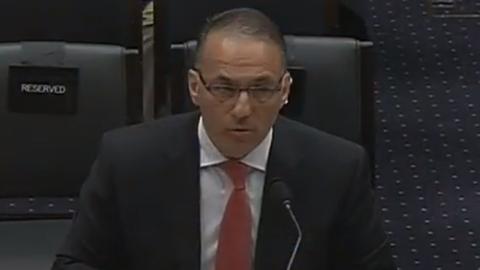On March 14th, 2018, Mario Mancuso testified before the U.S. House Committee on Foreign Affairs. Following is the full text of the testimony:
Chairman Royce, Ranking Member Engel, and other distinguished members of the Committee, thank you for the opportunity to testify this morning. I’m delighted to be with you, and with my distinguished fellow panelists.
My name is Mario Mancuso. Over the course of my career in government, I have had the privilege to serve in a variety of roles across the US national security and foreign policy enterprise, including as Under Secretary of Commerce for Industry and Security, Deputy Assistant Secretary of Defense for Special Operations and Combating Terrorism, a member of the Global Markets Board of the National Intelligence Council, and as a forward deployed military officer during Operation Iraqi Freedom.
In these roles, I learned a great deal about how US national security is conceived, debated and articulated in the interagency; how statecraft is operationalized; and how U.S. national security objectives are advanced “on the ground.” I also learned a great deal about the difference between ideas and execution; inputs and outputs; the importance of legal authorities, resources and accountability; and the need for modesty, especially in presuming what we know and do not (and cannot) know and do.
Today, I am a Visiting Senior Fellow for International Security at the Hudson Institute, where I continue to work on questions relating to US strategy and statecraft in the emerging security environment. I am also a partner at Kirkland & Ellis LLP, where I advise clients with respect to matters that may implicate the US’s national security regulation of international business activities, including with respect to CFIUS and export controls.
To be clear, I am here today in my personal capacity. The views I express here are mine alone, and should not be understood to be the views of Kirkland & Ellis or of its clients. I am here to offer some observations, in my capacity as a former government official, about these topics and to answer your questions about the imperative of US technology leadership, the international security profile and interests of the United States, and the role that CFIUS and export controls play in serving those interests. I will not discuss any specific case or matter that has been, or is currently before, the US government.
As this Committee knows well, both CFIUS and export controls are important instruments of US national security statecraft. By design, they aim to effectuate a selective “denial strategy,” which itself is premised on an important assumption: that the US has certain things that others want but do not have.
While globalization has rendered that assumption outdated in many areas, for certain emerging and foundational technologies (e.g., artificial intelligence, robotics, augmented/ virtual reality, etc.) that assumption is still generally true.
On the other hand, while globalization has diminished our lead in certain technology areas, it has also been central to our economic and, by extension, our national security success. One need only look at US overmatch advantages in nuclear and electronics-enabled capabilities at critical junctures in our history to see how economic scale and technological superiority worked hand in hand in service of our global preeminence.
In this connection, as this Committee considers the contribution of CFIUS and export controls to US national security, I would invite the Committee to keep in mind two national security-related questions which may help frame its deliberations:
* At this time in our history, what is the optimal balance for the US to strike between economic openness and restrictiveness in order for the nation to secure the most important advantages of openness while mitigating its greatest risks; and
* Whether, in light of that desired equilibrium, CFIUS and the current export control regime is, by virtue of their respective legal authorities and resources, properly configured to effectively implement and maintain this balance in the current environment?
In the interest of facilitating our discussion today, I wanted to offer some preliminary observations:
* Foreign direct investment (FDI) is critical to U.S. economic vitality. Not surprisingly for an advanced industrial economy, the largest proportion of FDI into the U.S. occurs as M&A activity. In the US, FDI accounts for approximately 7 million domestic jobs and other positive, ancillary economic impacts. The collective economic strength and vitality of our economy-- to which FDI clearly contributes-- helps resource our investments in national defense and extends our “soft-power” reach around the world.
* While the US remains a preferred global destination for FDI, our global share of FDI has declined in recent years. Because of its many direct and indirect benefits, this should be concerning to US policymakers, including US national security policymakers. Indeed, nations today must compete for FDI. A failure to consistently attract sufficient (benign) FDI into the US would present a long-term, systemic national security risk to the US.
* While FDI is generally good, certain transactions do, in fact, present transaction-specific national security risks. The policy question to consider in the context of FDI, therefore, is not primarily how to balance economics and national security interests, but how to balance systemic and transaction-specific national security risks.
* In recent years, strategic competition between the U.S. and China has increased across multiple domains--economic, political, and military. There is no reason to believe that such competition will abate in the coming years.
* China is actively pursuing a well-resourced, coordinated science and technology strategy that seeks to bolster “indigenous” Chinese innovation and to position China to be the world’s technology and innovation leader. A number of pillars of this strategy are described in various official Chinese government pronouncements, such as “Made in China 2025”, a number of Five-Year Plans, and certain published technology roadmaps. If successful in its articulated form, this strategy would have important Chinese economic and social benefits, contribute positively to the US-China economic relationship, and have deleterious impacts on US national security.
* Export controls have a long history in the US. In recent history, their defining policy challenge was during the Cold War, when they helped to manage strategic competition with the Soviet Union. During this period of Western solidarity and significant technological change, export controls worked reasonably well to prevent the illicit export of technology to Warsaw Pact countries. Since the Cold War, export controls have been significantly updated from time to time to address a broader set of US national security challenges. During this period, export controls have sought to balance, among other things, a complex bilateral relationship with China and the imperative to secure U.S. access to foreign technology markets in order to sustain scale economies to help fuel U.S. technology innovation, all against a backdrop of rapid and significant technological change and economic competition with strategic allies and others.
* As a matter of legal authority, export controls apply to the transfer of specific or general types of technology to foreign persons generally. In other words, their reach is not limited by law to a prescribed set of commercial circumstances (g., a corporate transaction). The controls themselves vary by technology type, end-use and end-user, and are designed to advance one or more national security, foreign policy or other goals. The system is highly complex and nuanced.
* Historically, most FDI in the US came from Organization for Economic Cooperation and Development (OECD) countries, many of whom are formal US allies. By contrast, in recent years an increasing number of investors have come from Asia, especially China, as global liquidity has moved east. This macro-economic trend is generally considered a secular one and expected to continue, despite periodic political or cyclical economic volatility.
* As a matter of legal authority, CFIUS has legal jurisdiction over many, but not all, transactions. Three things must be true for a transaction to be a “covered transaction,” and thus fall within CFIUS’s jurisdictional perimeter: (a) the buyer or investor must be “foreign person”; (b) the transaction must be a “control” transaction; and (c) the target business must be a “US business.” Each of these are terms of art, and broadly construed as a matter of agency practice. While CFIUS’s reach is broad, it is not infinite.
* Export controls and CFIUS have different, independently important, and complementary responsibilities. As Congress considers reforming one or both, it should focus its review primarily on gaps in resources as well as legal authorities.
* US technology leadership is essential, particularly with respect to certain emerging and foundational technologies, to long-term US national security interests. To achieve this, the US should pursue a whole-of-government strategy that does not rely exclusively on CFIUS and export controls--or see these as the exclusive vectors of risk-- but builds “strength on strength” by countering illicit technology transfer (however that may occur) and enhancing the US’s economic competitiveness and technological superiority.
Thank you, again, for the opportunity to be with you today, and for your commitment to exploring these important issues. I look forward to your questions.



















